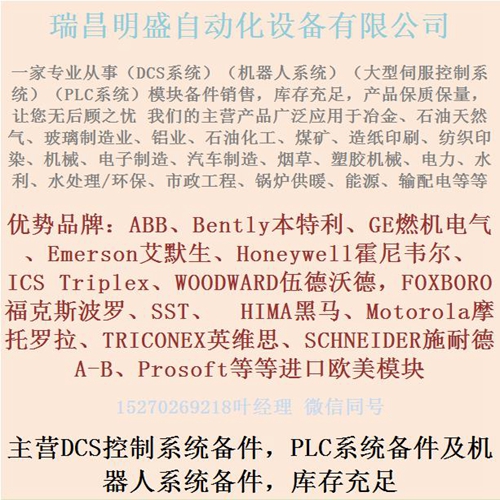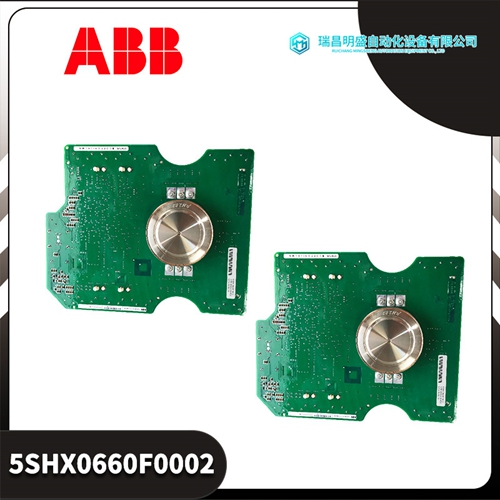公司主营产品图展示

产品优势
1:国外专业的供货渠道,具有价格优势
2:产品质量保证,让您售后无忧
3:全国快递包邮
4:一对一服务
公司主营产品文字介绍
PLC可编程控制器模块,DCS卡件,ESD系统卡件,振动监测系统卡件,汽轮机控制系统模块,燃气发电机备件等,优势品牌:Allen Bradley、BentlyNevada、ABB、Emerson Ovation、Honeywell DCS、Rockwell ICS Triplex、FOXBORO、Schneider PLC、GE Fanuc、Motorola、HIMA、TRICONEX、Prosoft等各种进口工业零部件、欧美进口模块。
产品广泛应用于冶金、石油天然气、玻璃制造业、铝业、石油化工、煤矿、造纸印刷、纺织印染、机械、电子制造、汽车制造、塑胶机械、电力、水利、水处理/环保、锅炉供暖、能源、输配电等等
产品详情内容介绍
6018BZ10200C主控制卡
模块安装包括以下内容:打开模块包装;设置配置交换机;在壳体中安装键销;在中安装模块住房连接连接器。按如下方式配置交换机组A:z A-1至A-6适用于预期输入电压范围八路或四路配置
z A7选择八路或四路输入模式。
z正常操作时,A8至ON。如果正在使用电流检测输入电路,则跨接适当的电流检测现场连接器上的端子连接至相应的热输入(+),如现场所示下面的连接器/输入电路引脚分配图。
注:应终止未使用的输入,以降低电气噪声和由于浮动输入线引起的其他干扰。跳线未使用电压和电流端子(包括屏蔽)至外壳接地。外壳接地仅为如果H8XX外壳接地,则有效。护罩的两端不能连接到设备和模块,除非设备屏蔽是一部分装置输入电路,且未在内部连接至装置外壳地
注:如果需要超范围和欠范围检测导致未使用通道的吞吐量问题(因为它们是浮动的或峰值超出范围),则现场连接器应并联至有效的输入通道。只要由于有效通道保持在有效范围内,绑定通道也将保持在范围
注:对于4-20 mA范围内的电流,仅有效输入需要包括250Ω电阻器。一般特征B875–111模数(A/D)输入模块(B875)转换输入电压和/或将电流范围输入二进制数据。此模块可以配置为接受8个差分或16个单端输入。当为8个差速器选择时输入,该卡称为B875–111。当为16个单端输入选择时该卡名为B877–111。
请参阅下面的简化示意图。
B875模拟输入模块允许广泛的现场设备轮询根据不同的应用需要不同的电压和电流。
可以在模块范围内从五个可用输入电压范围中进行选择。这个范围为0至5 V、1至5 V,--5至5 V和0至10 V,以及-10至10 V通过模块配置开关上的四个DIP开关选择。
可以从三个可用的输入电流范围中进行选择,即0至20 mA、4至20 mA和-20至+20 mA。
可以从四种可用的输出格式中进行选择。格式是标准的,通过打开两个DIP开关选择提升、全分辨率和十进制模块配置开关。
可以选择不求平均值,也可以选择要求平均值的8、16或32个样本输入通过模块配置上的两个DIP开关生成每个输出转换该模块有8/16个模拟输入,能够更新所有地震道每10-20毫秒。大于12位的分辨率和绝对0-60°C时的精度为0.1%,可精确控制应用。
Field Connector/Input Circuit Pinout Diagram
If current sense input circuit(s) is being used, jumper appropriate current sense terminal on field connector to corresponding hot input (+) as shown in field connector/input circuit pinout diagram, below. NOTE: Unused inputs should be terminated to reduce electrical noise and other interference due to floating input lines. Jumper unused voltage and current terminals (including shields) to case ground. Case ground will only be effective if H8XX housing is connected to earth ground. Both ends of the shield cannot be connected to the device and module, unless the device shield is part of the device input circuit, and is not connected internally to the device case ground. NOTE: If over-range and under-range detection is required, and this detection is causing throughput problems with the unused channels (because they float or spike outside the range) then the unused voltage or current channels at the field connector should be connected in parallel to a valid input channel. As long as the valid channel stays within range, the tied channels will also stay within range. NOTE: For currents within the range of 4—20 mA, only the valid input requires the inclusion of the 250 Ω resistor.
General Characteristics
The B875–111 analog-to-digital (A/D) input module (B875) converts input voltage and/or input current ranges into binary data. This module can be configured to accept 8 differential or 16 single ended inputs. When selected for 8 differential inputs, the card is called a B875–111. When selected for 16 single ended inputs, the card is called a B877–111. Refer to the simplified schematic below. The B875 analog input module allows the polling of a wide array of field devices requiring different voltages and different currents based upon a unique application. One can select from five available input voltage ranges on a module-wide basis. The ranges, which are 0 to 5 V, 1 to 5 V, --5 to 5 V, 0 to 10 V, and -10 to 10 V, are selected by means of four DIP switches on the module configuration switch. One can select from three available input current ranges, which are 0 to 20 mA, 4 to 20 mA, and -20 to +20 mA. One can select from four available output formats. The formats, which are standard, elevated, full resolution, and decimal, are selected by means of two DIP switches on the module configuration switch. One can select either no averaging, or 8, 16, or 32 sample inputs to be averaged to generate each output by means of two DIP switches on the module configuration switch. The module has eight/sixteen analog inputs and is capable of updates to all channels every 10—20 msecs. The greater than 12-bit resolution and the absolute accuracy of 0.1% at 0—60° C provides precise control of the application.








